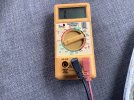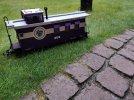0.58 amps seems pretty high for no train on the track. Your three switch decoder modules and two reverse-loop modules only consume 20 - 30 mA each. That's 0.2 A max being very generous. What's eating up the other 0.4 amps?
To give some perspective I've got 2 x LGB 4 ch switch decoders, 2 x Massoth 4ch switch decoders, 4 x LGB single ch switch decoders, 1 x MD Electronics single ch switch decoder, 1 x LGB reverse-loop module, and 14 x 0.013A LEDs powered when no trains are on the track. My total amperage is 0.42A
To give some perspective I've got 2 x LGB 4 ch switch decoders, 2 x Massoth 4ch switch decoders, 4 x LGB single ch switch decoders, 1 x MD Electronics single ch switch decoder, 1 x LGB reverse-loop module, and 14 x 0.013A LEDs powered when no trains are on the track. My total amperage is 0.42A




